Chausathi Yogini Temple - Roofless Architectural Wonder of Odisha
The unique circular open roofed temple is one of the four surviving temples in India of the yogini cult which flourished in the country from the 8th Century AD to 13th Century AD.There are four surviving yogini temples in the country. Out of the four such temples two are located in Odisha (one in Hirapur and the other one in Ranipur-Jharial in Bolangir Dist and the other two are in modern day Madhya Pradesh).Chausathi is one such temple and must see site dedicated to tantri yogini cult even today.
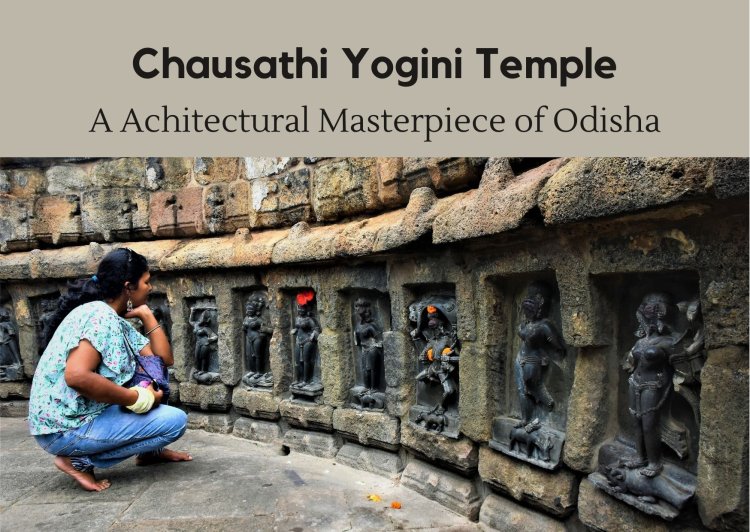
With the very mention of a roofless temple with 64 Yoginis by our tour guide, without a second thought, I was curious to visit the place. We were on our tour in Bhubneshwar in the temple city of Odisha. After visiting the Raja Rani Temple our next place was Chausathi Yogini Temple, in Hirapur just few kilometers from Bhubneshwar.
We reached the temple enclosure surrounded by lush green paddy fields and a monument maintained by ASI,
What are Yoginis ?
Yogini is a Sanskrit term for a female master practitioner of yoga, as well as a formal term of respect for female Hindu or Buddhist spiritual teachers or goddesses in the Indian sub-continent or demi goddesses worshipped for tantric practices too.
The term is the feminine Sanskrit word of the masculine yogi, while the term yogin is used in neutral, masculine or feminine sense. Yogini (jogan) is a term in ancient and medieval texts in Hinduism, Buddhism and Jainism, typically in the context of and as an aspect of Devi.
A Yogini, in some contexts, is the sacred feminine force made incarnate, as an aspect of Godess Parvati,the consort of Lord Shiva and revered in yogini temples of India as the Eight Matrikas or the Sixty-four Yoginis. The object of worship was usually a Chakra or Wheel which had sixty-four spokes, hence the name (Chausathi translates to sixty-four in Odia). The presiding deity is Goddess Kali. The yogini’s are believed to be offshoots of the Saptamatrika and are incarnations of Shakti and depicted as vivacious and seem to embrace life rather than withdraw from it. The yoginis define and represent the ultimate feminine power.
Their temples are usually found with a group of 64 of them. The yoginis are depicted in the form of chakra, and probably that is why their temples are built in a Circular, form of a chakra or a wheel formation. Each yogini poses on a spoke of this wheel in different postures.
These are 64 Yoginis below
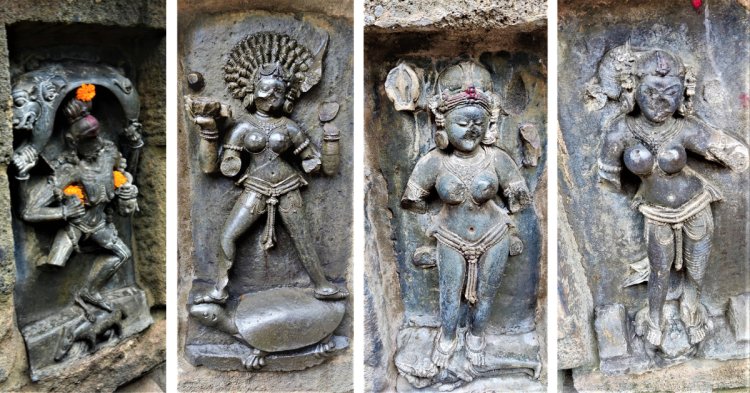
Bahurupa
Tara
Narmada
Yamuna
Shanti
Varuni
Kshemankari
Aindri
Varahi
Ranveera
Vanara-Mukhi
Vaishnavi
Kalaratri
Vaidyaroopa
Charchika
Betali
Chinnamastika
Vrishabahana
Jwala Kamini
Ghatavara
Karakali
Saraswati
Birupa
Kauveri
Bhaluka
Narasimhi
Biraja
Vikatanna
Mahalakshmi
Kaumari
Maha Maya
Rati
Karkari
Sarpashya
Yakshini
Vinayaki
Vindya Balini
Veera Kumari
Maheshwari
Ambika
Kamiyani
Ghatabari
Stutee
Kali
Uma
Narayani
Samudraa
Brahmani
Jwala Mukhi
Agneyei
Aditi
Chandrakanti
Vayubega
Chamunda
Murati
Ganga
Dhumavati
Gandhari
Sarva Mangala
Ajita
Surya Putri
Vayu Veena
Aghora
Bhadrakali
( The list of yoginis differs from different yogini temples in India )
Each one of them has a name that we identify with, but no two temples have the same order This tells us that the local worshippers might have had the choice of yoginis during the construction of temple. Idols inside the wall are in different gestures, moods and few look ferocious. Each of them has certain powers and you worship the one who can fulfill your wish, which could be anywhere from getting a child to destroying an enemy.
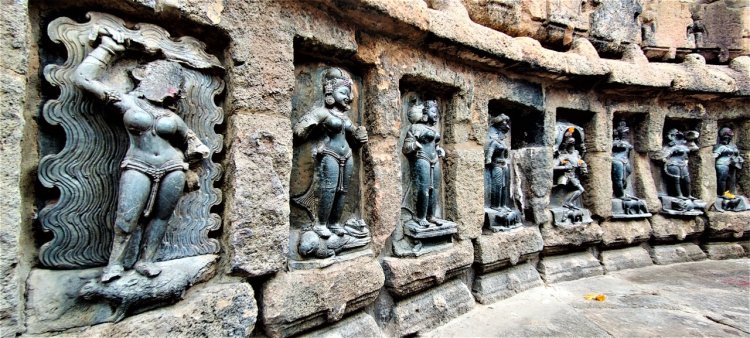
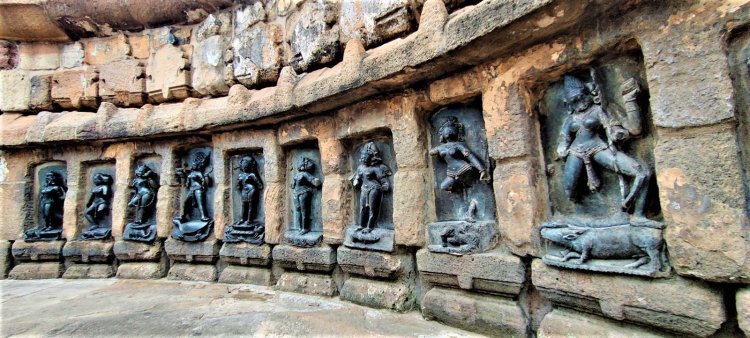
History of Chausath Yogini Temple
The temple date back to somewhere in 9th CE. Goddess Mahamaya was been reverred by the local villagers. It was however deciphered by the Kedarnath Mahapatra of Odisha State Museum in 1953. Since then, it has been under ASI. My sense is that the temple would have always been a practice.
It is said to be built by Queen Hiradevi of the Bhauma dynasty, a dynasty that was ruled by women successors.. In fact, the village that has this temple is called Hirapur after the queen. The temple is locally called Mahamaya Temple, after the presiding deity.
Reasons behind the construction of the temple by a queen, whether she was an ardent worshipper of Shakti or for his followers are yet to be known.
Kalapahad, a converted Muslim general of 16th CE is said to have defaced the temple, as well as broken the Murtis. He is famously known as the destroyer of Puri and Konark temples.
Chandi Pitha
The circular wall inside has 60 Yoginis, the other four were on the central square platform called Chandi Pitha. Of these 4, only 3 are there right now, and one is missing. There are 4 sculptures of 4 Bhairavas in 4 niches here. Devi temples always have the presence of Bhairava.
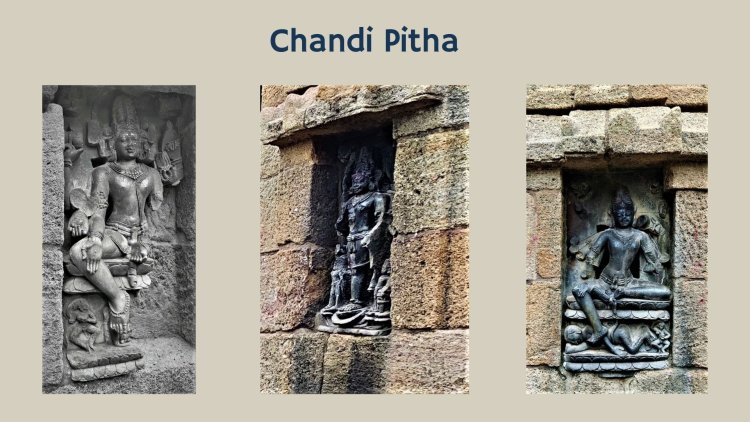
A close observation reveals that there was an image of Lord Shiva in the center, but the priest did not mention it. As of now, no one sits on this Chandi Pitha. All the Pujas are done in front of Mahamaya.
Exterior Wall of Temple
The outer wall is relatively simpler. It has nine niches at regular intervals with nine Devi Murtis. They are called Nav-Katyayanis or Nava-Durga. Priest related them to the nine forms of Durga that are worshipped during the Navaratri. But I could not relate the imagery to those forms of Shakti. It is possible there is another interpretation that I am not aware of.
Outer Murtis are larger in size than the inner ones. They are standing on dead bodies or dogs or jackals, the animals typically found near dead bodies. Remember some tantric practices involve the use of dead bodies, the reason you see many tantric at the cremation grounds. In their hands, they hold different weapons.
Figures are seen standing on heads in different postures, sporting a parasol on heads, with assistants, wielding a weapons.
Few of the idols have been damaged by invaders, Devotees visiting the temple seem to light oil lamps in devotion and idols look charred. Hence defacing the image and monument!
Chausath Yogini Utsav
Every year on 23 - 25th December, every year Chausath Yogini Mahotsava is celebrated. The Odisha dance and music are performed on a stage right outside the temple.
A big Yagna is performed on Magh Saptami.
Chandi Path is done every day during the Navratri festival.
Travel Tips for Hirapur – Chausath Yogini Temple
- Hirapur is about 15 KM from Bhubaneshwar city.
- Temple is a protected monument and maintained by ASI, but the local priest takes care of daily puja rituals
- It is open from 6 AM – 7 PM. Evening Aarti takes place just before the closing of the temple.
- Early morning is the best time to visit the temple. Mind your head, as the entrance to the temple, is low. !
- There is no entrance fee, though its an ASI monument. Devotees can donate as per their wishes.













